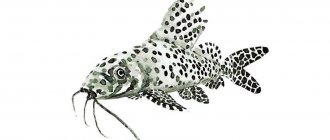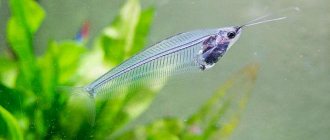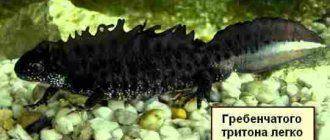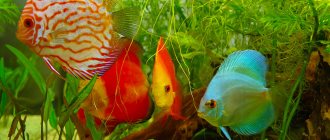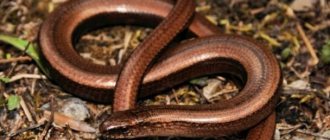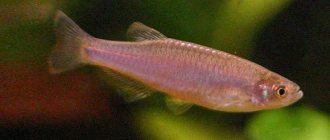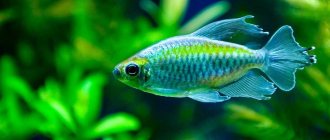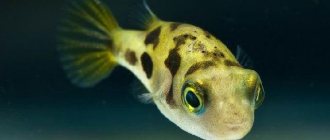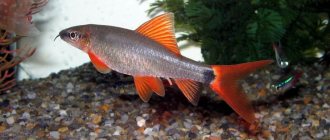Salvinia eared
Salvinia eared grows naturally in standing and slow-moving waters of the tropical zone of South America.
Externally, salvinia eared differs from the previous species in that it has smaller and round leaves with a yellowish tint. Salvinia got its name from the shape of a leaf segment, somewhat reminiscent of an ear, clearly visible in developed plants. This plant needs bright overhead lighting and a water temperature of 20-25°. In winter, salvinia eared grows well only in the presence of long-term artificial lighting.
Which neighbors will they feel comfortable with?
Having a significant aquarium size, an aquarist can complement a pair of Cichlizoma salvini with worthy neighbors. First of all, these must be individuals of significant size and active lifestyle. Other types of adult cichlids, sacbranch catfish, and possibly mature gouramis would be suitable. A definite “no” to gentle and sensitive natures, as well as to babies like neons and guppies.
Secondly, the image of entertainment should be taken into account. Species of fish that uproot plants and thereby create muddy water will create extreme living conditions for Salvini.
Thirdly, it is better to combine according to the typical habitat in the aquarium. Individuals living in the lower layers of water harmoniously complement cichlases: they clean the aquarium of settled waste and do not interfere with upper feeding.
Cichlosoma salvini is a worthy inhabitant of the home pond. True, for this she needs to understand that she is the main one in the house.
Post Views: 2,385
Maintenance and breeding
Salvinia is not too demanding - it needs good lighting and regular water changes. The average temperature at which fern feels best is 20-30 degrees. But keep in mind: the warmer the water, the faster salvinia grows and the larger its leaves become.
Salvinia reproduces by spores, but vegetative propagation is also common - it is not at all difficult, and there is no need to plant anything. To do this, you just need to separate a part of the fern with a stem and leaves and place it in favorable conditions where it will begin to grow.
With a sharp cold snap and decreased light, plants die en masse, but dead ferns retain spores, which, with the onset of warmth and light, give life to a new generation of ferns. Death in the cold is the normal end of the development of a fern; in nature, this ends its life cycle. But at home this is, of course, easy
The underwater leaves of Salvinia eared protect the inhabitants of the aquarium from bright light, serve as a refuge for fry and a spawning site for a number of fish. The plant does not like falling drops of water, so the cover glass must be placed at an angle so that the drops flow to its edge. In an aquarium, in favorable conditions, Salvinia eared grows all year round.
Salvinia eared prefers bright light. It is recommended to use fluorescent lamps or special phytolamps as sources of artificial light, the power of which must be at least 3 W per 1 dm2 of area. It is not recommended to use high-power incandescent lamps, as they dry out the air greatly. Daylight hours are at least 12 hours
Feeding
First of all, you need to remember that this is a predator and live food will be the first delicacy. For example, frozen bloodworms, coretra or tubifex. To prevent and maintain excellent health, cichlazoma Salvini can and should be given food of plant origin, as well as special food in the form of dried seafood, earthworms, granules or flakes. It’s great if you have the opportunity to pamper yourself with small live fish.
A balanced diet is considered to be food that contains ¾ protein and ¼ vegetable fats. Also, Salvini's cichlizoma will not mind eating home-made minced meat, consisting of:
- poultry meat
- herbal supplements
- seafood
Benefits for the aquarium
Salvinia capulata
Salvinia greatly decorates a home pond, especially if we are talking about aquariums that are quite wide and low, whose surface is located below the human eye. The surface of the water, decorated with a whimsical green pattern, is very impressive. However, the usefulness of aquatic fern does not end there.
This fern is very important for maintaining the harmonious balance of a miniature pond.
Aquatic fern actively absorbs many hazardous substances dissolved in water: ammonia and ammonium, phosphates, nitrites, cadmium, lead and heavy metals. This significantly improves and heals the aquatic environment. Therefore, the plant will be very appropriate in aquariums where fish and shrimp are demanding on the composition of the water.
It coexists perfectly with aquatic mosses, combines aesthetically well with them and, in addition, protects them from fouling.
The roots of salvinia hanging into the water column serve as an excellent refuge for fry, juveniles, and miniature peaceful fish. And salvinia leaves floating on the surface of the water, the whorls of which look like a green flower, are very popular with newts - they lie on them on the surface of the water.
Salvinia will also help get rid of unwanted plant inhabitants of the aquarium. For example, it completely survives duckweed from the surface, leaving no food for it.
Care
Salvinia is unpretentious in care. The main thing is to provide good lighting and a constant temperature.
Water parameters
The fern prefers warm bodies of water, which warm up to temperatures above +20 °C. Salvinia will withstand lower temperatures, but then it will grow more slowly.
For a good growing season, it is also worth taking into account acidity - it should not exceed 8 pH - and water hardness - up to 15 dGH .
Trimming
The growth of the bush must be constantly regulated, otherwise the fern will cover the entire surface of the water. During pruning, all lateral shoots are removed and the length of the stem is slightly shortened.
Lighting
Ferns require long daylight hours.
If it is not possible to place an aquarium with salvinia in a place where there is a lot of sun, you need to provide additional lighting : a lack of light can lead to the death of the plant.
How to plant salvinia
Planting salvinia is very simple - just throw the seeds into the water and wait for the sprouts to appear.
Fertilizer
Fertilizers are not required for successful fern growth, since it receives all the necessary microelements from water.
Origin and habitat
Salvinia is a fern plant. Its natural habitat is water bodies of Asia, Africa and Europe. In Russia, even in the southern regions, it takes root poorly - the seasonality and conditions do not coincide with those necessary for the development of the fern.
The plant is light-loving; in a warm and well-lit environment it grows throughout the year without completing its life cycle. During seasonal cold spells, most of the plants die, but even among the dead, spores remain, which provide life to new plants with the onset of spring.
Reproduction
Floating fern can be propagated in two ways:
- disputes;
- vegetatively.
Disputes
A new plant is formed from salvinia spores, but this process is only possible in a natural reservoir.
On a fern leaf submerged under water, sori are formed, in which the process of spore formation takes place .
When autumn frosts occur, the parent fern dies and the sori fall to the bottom.
In spring, when the water temperature rises, the sori float to the surface, their shell becomes thinner, and spores begin to germinate.
Varieties
floating salvinia
- Salvinia floating. The most common and stable variety. Salvinia floating looks like rounded small leaves floating on the surface of the water. The leaves are covered with fine hairs. Thin stems extend from them into the water column. Salvinia floating is very tolerant of water temperature, but it needs plenty of lighting, especially overhead lighting that falls directly on the leaves. Salvinia floating, like other species of this aquatic fern, loves fresh water and good filtration. The plant tends to grow quickly and vigorously, so you need to regularly remove some of the plants.
- Salvinia eared. A South American species of aquatic fern that is also found in Central America. Salvinia eared grows in tropical areas, preferring bays with stagnant water and branches of rivers with slow currents. Salvinia eared is more demanding on temperature than salvinia floating: it loves warmth. Therefore, a warm aquarium, tropical, with a fairly high ambient temperature, is suitable for keeping the plant. Salvinia eared has three leaves in a whorl, with only two of them, symmetrically located opposite each other, located on the surface. The third leaf, narrow and forked, is lowered into the water. These underwater salvinia leaves provide excellent cover for the fry.
- Salvinia capulata. Comes from reservoirs located in South and East Asia. Salvinia capulata has a pleasant bluish-green color of pubescent leaves that float on the surface of the water. The leaves in the whorl have an interesting shape - they are slightly curled at the base, resembling a miniature bag or hood. From this form, Salvinia klobukovaya got its name: klobuk - monk’s hood. Just like other types of aquatic fern, it loves warm, fresh water.
Description
Salvinia floats on the surface. It obtains food from the water column.
Appearance
The stem is 10–12 cm long, spreading horizontally. Three-leaf whorls. The characteristic distance between whorls is 1-1.5 cm.
The two surface leaves are elliptical, light green or light green, the petioles are weakly expressed. The surface is lumpy, 1.5–4 cm long, 0.5–2 cm wide. The reverse side has reddish bristles. The third leaf is immersed in water: whitish hairy shoots similar to the root system, length - 6–10 cm.
Check out this addition on Instagram
Addition, expansions Marija Li (@nature_lover_li) 10 Gr 2022 r. about 3:03 PST
Structure
Surface foliage is intended for photosynthesis. Fleecy tubercles prevent the sheet from getting wet. The bristles on the inside retain air bubbles, providing the plant with buoyancy.
The “roots” absorb and store nutrients from the environment. Dense, they act as a keel (ballast) for a stable position of the plant. Under natural conditions they participate in reproduction.
Tips for aquarists
Some useful tips from knowledgeable people:
- You should not plant salvinia and pistia in the same aquarium, they interfere with each other, although they look great together in a pond;
- if the leaves turn yellow and fall off, it means the plant lacks magnesium and iron and needs micronutrient feeding;
- Salvinia is often planted to shade Anubias;
- put salvinia in an aquarium with newts, they love to lie on a floating cushion.
In the video, a specialist tells everything about the aquatic plant Salvinia floating.
Use at home
On the territory of a private house, you can set up a garden aquarium - an artificial pond with transparent walls, raised above the ground.
A flowerpot for the street can serve as a support. Salvinia will be very appropriate in such a reservoir: it will create shade for fish and other plants from direct sunlight.
The most unpretentious species is floating salvinia, but other species also feel great in the aquarium under the following conditions:
- constant t◦ of water in the recommended range (from 20 to 30◦C) with a difference in the environment of -5◦C;
- chemical composition: acidity - pH5-8; hardness —dH 4-15◦;
- sufficient illumination (1-3 W/liter), especially during the growth period (spring-summer) using fluorescent or phytolamps;
- slight movement of water;
- standard air humidity (determined by the ratio of the surface area of the aquarium to the area of the room, which should be no more than 2%);
- no condensation on top;
- Regular renewal of water in the aquarium (weekly - up to a quarter of the volume).
An aquarium with salvinias does not need to be covered with glass, which can cause unwanted condensation. The floating plant itself protects the ecosystem of the artificial reservoir from excessive evaporation of moisture.
Selaginella coming to life
Selaginella rediviva belongs to the Moss family and grows in shady places in the mountainous countries of California. Europe became acquainted with it only a few years ago, thanks to the famous botanist Furrer.
This plant, in addition to sporangia with small spores (microspores), also has fruits with 4 large spores (macrospores). In the latter, archaeogonia develop, and in the smaller ones, wandering filaments develop.
Like all Selaginella, it has a branching creeping stem with root lobes. But its peculiarity lies in the fact that in its homeland it is in a dried-out state almost all year round and only three or four times, after heavy torrential rains, it comes to life and turns from brown to a charming green. However, this greenery does not last long, since after the first hot rays of the sun it closes and shrinks again.
It is not difficult to imitate this curious natural phenomenon if this floating plant, usually sent in dried form, is placed in an aquarium with not very cold water. After 12-36 hours it will completely bloom and turn from brown to the most lovely bright green. It retains this color as long as it remains in water or even until it is lightly covered with it. But as soon as he is taken out of here, he will immediately writhe, as if under the influence of some intense heat, and turn brown again.
In this form it can be preserved for months, years - in a word, until it is put into water again. However, it should not be kept in water constantly, because for its existence it requires as much air as water.
This plant is 15-17 centimeters in diameter and is not only convenient for keeping in aquariums, but even in a simple jar of water.
These photos illustrate surface plants for the aquarium, the names of which are given in this material:
Benefits of setting up a slow herbalist
In addition to the fact that the herbalist is easy to care for, it has another undeniable advantage - low cost of maintenance and upkeep. You practically eliminate the need for aquarium chemicals, and you also won’t spend money on carbon dioxide cylinders.
If you use mosses when decorating, then this is also a good saving on nutritious soil. And you will need low-power lamps, but correctly selected in terms of glow temperature, in order to ensure the slow but healthy development of plants and to avoid the appearance of algae.
It is better to use fluorescent lighting. Daylight hours in a slow herbalist are about 6 hours. With longer illumination (up to 10 hours), hard-leaved plants begin to become covered with an unwanted coating - beard, xinococcus, etc.
Common diseases
Most hydrobionts are sensitive indicators of environmental conditions. Lack of lighting, macro- and microelements, and temperature fluctuations affect the appearance and growth of plants.
Main symptoms
Symptoms that require immediate correction of living conditions:
- yellowing - deficiency of iron, phosphates;
- lightening of the plate and darkening of the veins - lack of magnesium;
- the appearance of holes with a yellow edge - lack of potassium;
- plate grinding - low temperature;
- decreased growth rate - lack of CO²;
- spoilage of roots - caked, compacted substrate;
- thin, weak, pale stems - lack of light;
- stunted, weak plates - stagnant water.
If algae growth appears on the leaves, it may be due to too much light.
Treatment options
Depending on the cause of the disease, treatment is prescribed.
First of all, you need to compensate for the damaging factor: add the necessary micro- and macroelements, increase/decrease lighting, and change the water.
If the plant continues to hurt, you should continue the diagnosis and find out the cause.
The importance of the plant for the ecosystem
Salvinia as aquarium flora
- aerates water and purifies it from nitrates and heavy metals;
- creates a refuge for fish fry;
- provides protective shading for aquarium inhabitants;
- serves as a “resting place” for amphibians (newts);
Use in landscape design
- enhances the decorative effect of artificial reservoirs;
- helps purify water in small pools and ponds;
- decorates the shoreline of a reservoir well.
